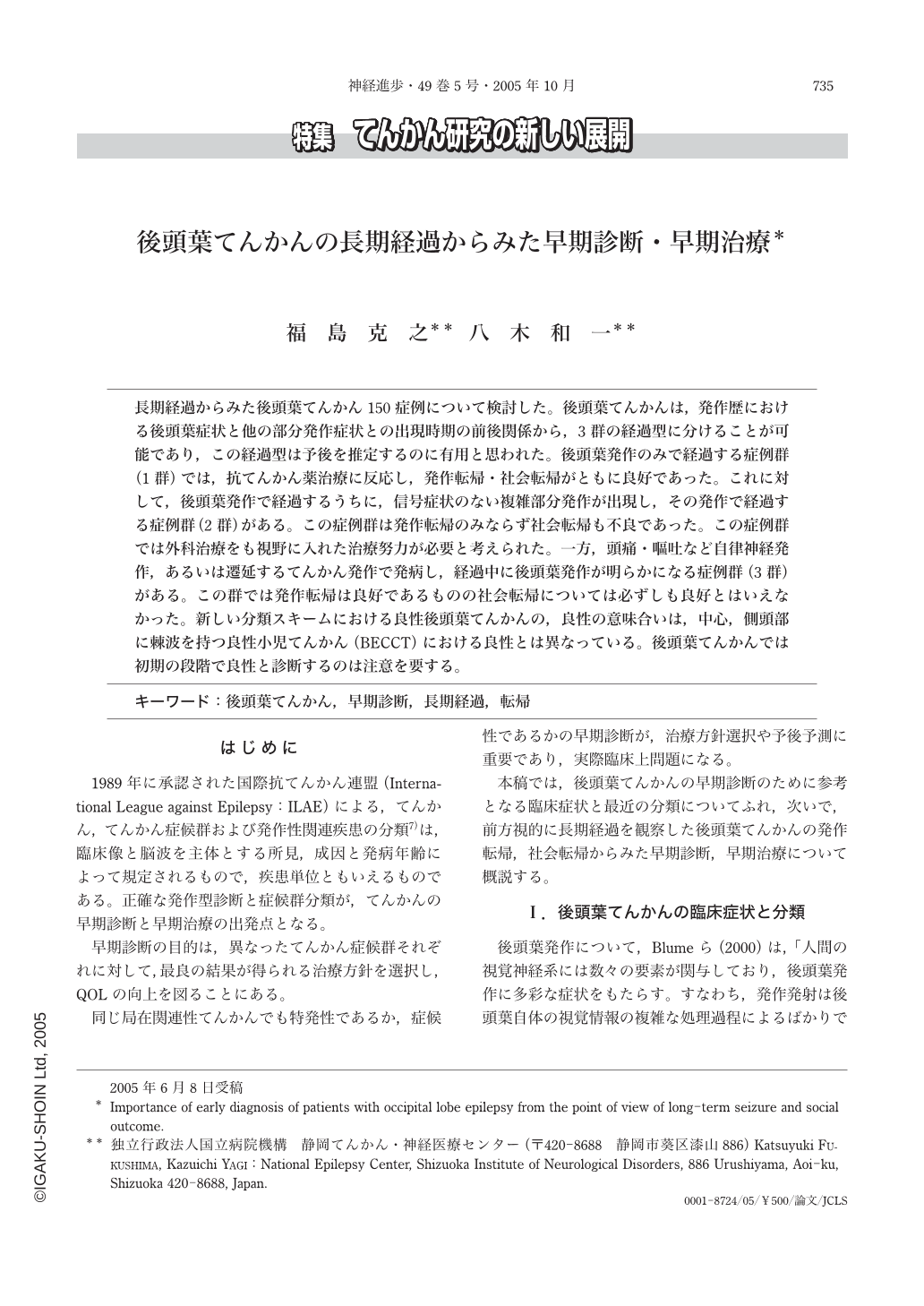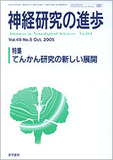Japanese
English
- 有料閲覧
- Abstract 文献概要
- 1ページ目 Look Inside
長期経過からみた後頭葉てんかん150症例について検討した。後頭葉てんかんは,発作歴における後頭葉症状と他の部分発作症状との出現時期の前後関係から,3群の経過型に分けることが可能であり,この経過型は予後を推定するのに有用と思われた。後頭葉発作のみで経過する症例群(1群)では,抗てんかん薬治療に反応し,発作転帰・社会転帰がともに良好であった。これに対して,後頭葉発作で経過するうちに,信号症状のない複雑部分発作が出現し,その発作で経過する症例群(2群)がある。この症例群は発作転帰のみならず社会転帰も不良であった。この症例群では外科治療をも視野に入れた治療努力が必要と考えられた。一方,頭痛・嘔吐など自律神経発作,あるいは遷延するてんかん発作で発病し,経過中に後頭葉発作が明らかになる症例群(3群)がある。この群では発作転帰は良好であるものの社会転帰については必ずしも良好とはいえなかった。新しい分類スキームにおける良性後頭葉てんかんの,良性の意味合いは,中心,側頭部に棘波を持つ良性小児てんかん(BECCT)における良性とは異なっている。後頭葉てんかんでは初期の段階で良性と診断するのは注意を要する。
Purpose:According to the Revised International Classification of Epilepsies and Epileptic Syndromes(Commission, 1989), occipital lobe epilepsy syndromes are characterized by simple partial and secondarily generalized seizures. Complex partial seizures may occur with spread beyond the occipital lobe. Occipital seizures may spread to the superior convexity and mesial surface of parietal, frontal and temporal lobes, thus mimicking every symptomatology of partial seizures, including frontal or temporal lobe seizures. The seizure outcome in relation to social status was studied in patients who were followed up for over 10 years.
Patients and Methods:The seizure types of 105 patients were confirmed electroclinically to be of occipital origin in 1993 and their seizure outcome and social consequences were examined in 2003. Their present age is 36 years old, ranging from 19 to 61. The inclusion criteria were:1)those patients who once showed positive or negative visual signs and/or oculomotor symptoms, in addition to, 2)presence of epileptic discharges on the posterior scalp leads, T5, T6, O1 and O2.
The 105 patients were divided into 3 groups based on observation over a 10-year evolutional course.
1)Group 1:38 patients having only visual and/or oculomotor signs all through the follow-up period.
2)Group 2:40 patients initially having visual and/or oculomotor signs, who afterward developed complex partial seizures(CPSs)and/or partial-onset generalized tonic-clonic seizures(pGTCs).
3)Group 3:27 patients initially having partial seizure signs suggestive of occipital lobe origin including nausea, vomiting, headache, prolonged CPS or pGTC, or unilaterally dominant convulsive seizures. Subsequently, these patients culminated in visual and/or oculomotor signs as sole seizure events.
Results:Presumed remote etiology was asphyxia and head trauma in all the 3 groups. Seizure outcome was defined as complete freedom from clinical seizures during the previous 1 year at the time of final examination. Compared to the unfavorable seizure outcome in patients in Group 2(15%), those in Group 1 and Group 3 attained obviously favorable outcome,(87%)and(80%), respectively. Three patients in Group 2 underwent resection surgery of occipital lobe that resulted in a complete freedom from seizures. We lost 1 patient in Group 2 due to cardiac failure as a result of status epilepticus. Seven patients out of 27 in Group 3 are considered to have benign childhood epilepsy with occipital paroxysms.
There were 9 patients who attained terminal remission, 6 patients in Group 1 and 3 in Group 3. Sixteen patients in Group 1, 2 patients in Group 2 and 7 in Group 3 were placed on AED mono-pharmacy.
In 50 patients out of the 105, marked improvement of social adaptability was observed at the endpoint, compared to 10 years previously. Social rehabilitation was most successful in Group 1 followed by Group 3, whereas in Group 2, the majority of patients still live in socially restricted status.
Discussion:Unlike benign epilepsy of children with centro-temporal EEG foci, it is suggested that the discontinuation of antiepileptic drugs was difficult, even if the occipital lobe epilepsy had a favorable outcome.
In Group 2, the chronic propagation, or spread of discharges to temporal lobe, which originated from occipital lobe were considered to associate with intractability of occipital lobe epilepsy.
Conclusion:Developing CPSs as initial signs reflected rapid spread of occipital discharge to temporal lobe and was associated with, not only unfavorable seizure outcome, but also difficult social rehabilitation, sometimes necessitating intensive therapeutic intervention including surgery.

Copyright © 2005, Igaku-Shoin Ltd. All rights reserved.


